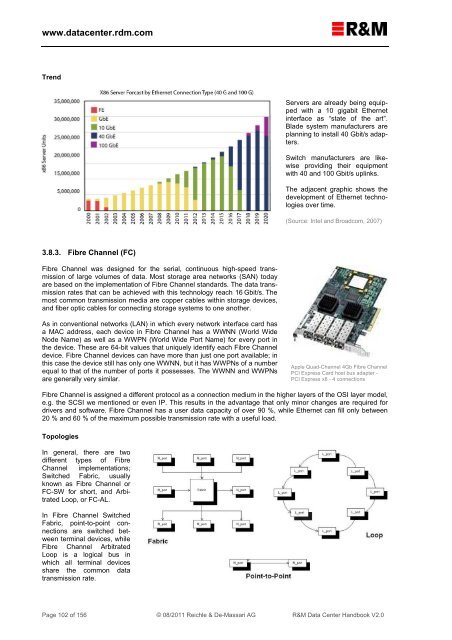R&M Data Center Handbook
R&M Data Center Handbook
R&M Data Center Handbook
You also want an ePaper? Increase the reach of your titles
YUMPU automatically turns print PDFs into web optimized ePapers that Google loves.
www.datacenter.rdm.com<br />
Trend<br />
Servers are already being equipped<br />
with a 10 gigabit Ethernet<br />
interface as “state of the art”.<br />
Blade system manufacturers are<br />
planning to install 40 Gbit/s adapters.<br />
Switch manufacturers are likewise<br />
providing their equipment<br />
with 40 and 100 Gbit/s uplinks.<br />
The adjacent graphic shows the<br />
development of Ethernet technologies<br />
over time.<br />
(Source: Intel and Broadcom, 2007)<br />
3.8.3. Fibre Channel (FC)<br />
Fibre Channel was designed for the serial, continuous high-speed transmission<br />
of large volumes of data. Most storage area networks (SAN) today<br />
are based on the implementation of Fibre Channel standards. The data transmission<br />
rates that can be achieved with this technology reach 16 Gbit/s. The<br />
most common transmission media are copper cables within storage devices,<br />
and fiber optic cables for connecting storage systems to one another.<br />
As in conventional networks (LAN) in which every network interface card has<br />
a MAC address, each device in Fibre Channel has a WWNN (World Wide<br />
Node Name) as well as a WWPN (World Wide Port Name) for every port in<br />
the device. These are 64-bit values that uniquely identify each Fibre Channel<br />
device. Fibre Channel devices can have more than just one port available; in<br />
this case the device still has only one WWNN, but it has WWPNs of a number<br />
equal to that of the number of ports it possesses. The WWNN and WWPNs<br />
are generally very similar.<br />
Apple Quad-Channel 4Gb Fibre Channel<br />
PCI Express Card host bus adapter -<br />
PCI Express x8 - 4 connections<br />
Fibre Channel is assigned a different protocol as a connection medium in the higher layers of the OSI layer model,<br />
e.g. the SCSI we mentioned or even IP. This results in the advantage that only minor changes are required for<br />
drivers and software. Fibre Channel has a user data capacity of over 90 %, while Ethernet can fill only between<br />
20 % and 60 % of the maximum possible transmission rate with a useful load.<br />
Topologies<br />
In general, there are two<br />
different types of Fibre<br />
Channel implementations;<br />
Switched Fabric, usually<br />
known as Fibre Channel or<br />
FC-SW for short, and Arbitrated<br />
Loop, or FC-AL.<br />
In Fibre Channel Switched<br />
Fabric, point-to-point connections<br />
are switched between<br />
terminal devices, while<br />
Fibre Channel Arbitrated<br />
Loop is a logical bus in<br />
which all terminal devices<br />
share the common data<br />
transmission rate.<br />
Page 102 of 156 © 08/2011 Reichle & De-Massari AG R&M <strong>Data</strong> <strong>Center</strong> <strong>Handbook</strong> V2.0


